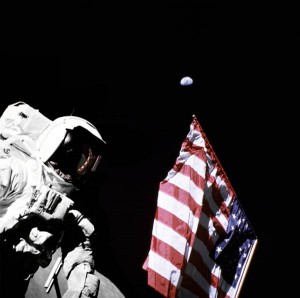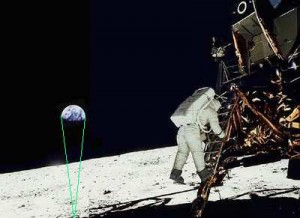Logic and math should work on and with hard data coming from direct experience and empirical measurements of experiments imitating nature’s ways. Nowadays it’s not the case – at least not in Science. Theories are based on other theories, hypotheses and axioms instead of hard data. Axioms are sacred and not to be questioned ever. Devices are constructed to verify theories instead of finding the truth. Other devices are designed on false relations of faulty theories and hypotheses. Common sense and good old geometry would provide good methods, devices and evidence, but they are completely neglected, though they are still superior to hypotheses. We are going to prove it in the following case: on Moon’s real distance from Earth and the true diameter of the Moon.Scientists are proud of knowing the distance between Moon and Earth exactly within two centimetres range. The distance has been “measured” by radar and laser methods. These are both based on the theory that light travels at the speed of 300000 km/sec in the vacuum of space though the speed of light had only been measured by questionable methods here on Earth, in air. The experiment has never been reproduced in outer space vacuum since mankind travels in space.
The diameter of the Moon has been “measured” by the time Moon’ disk travels through the shadow of Earth including umbra and penumbra though they were not aware of the fact that umbra and penumbra exist only on planets that have “air” of some kind around it, which scatters light to produce the penumbra on the surface. Also, penumbra exists only around the shadow of planets cast in space that has gas atmosphere around them. What is more, there is an other assumption in this “measure” namely that the size of Earth’s shadow remains the same in the distance of the Moon! Therefore Moon’s accepted 3460 km diameter is only a theorised size.
Moon’s angular diameter viewed from Earth’s surface is approximately half a degree; it is around 30 angular minutes. This alone is not enough to calculate the diameter or the distance. Together with the diameter faultily derived from the time of lunar silhouette passing through Earth’s shadow it was enough to calculate Moon’s mean distance a 382.000 km. Here also there is a factor not taken into consideration. It is the effect of the atmosphere on all angles when the Moon is viewed from the bottom of the atmosphere that is, like viewing it from the inside of a lens. What if the angular diameter is bigger when seen from above Earth’s atmosphere?
Anyway, the distance between Earth and Moon and Moon’s diameter is far more important than commonly thought because every distance, diameter and mass in the Solar System is calculated on the “known” dimensions of Earth and Moon.
The only foolproof method to measure the distance between celestial bodies is good old geometry. Mostly triangulation and the relations of angles can be used for this purpose.
Therefore, the best method to really measure the distance between Earth and Moon is to measure the angular diameter of the Moon from the ISS orbiting outside Earth’ atmosphere, and measure Earth’s angular diameter from the Moon. The problem is it has never been done on the Moon while Apollo crews were on its surface. But it is not too late. They brought back photos taken on the Moon on which the Earth can be seen in the background. Therefore we can measure the angular diameter of Earth on them. What is more, SELENE probe has also taken pictures and made a video while orbiting Moon. We can use these, too. It is not the best way to do it, but good enough to find out whether Earth’s angular diameter from the Moon is really 1,8 degrees as had been theorised. Moon’s angular diameter can also been measured on the photos taken by ISS crew.
Let’s see the photos on Earth first.
On all of these photos Earth’s angular diameter is measured about 5 (five) degrees instead of the theorised 1.8 degree!
Next, see the photos on the Moon taken from ISS.
On both of these photos Moon’s angular diameter is measured somewhere between 1.5 to 2 degrees instead of the 30 minutes seen from Earth.
When both angles are measured, the next step is to draw these angles onto a long ribbon of paper and turn the two angles facing each other. The two points where the angles cross each other such a way that Earth’s diameter (12750 km) 12.75 cm in a small scale, and Moon’s small scale diameter meets the lines of the particular angles will give us the distance between them in small scale.
Let’s see it first with the Moon’s 30 minutes angle from Earth.
You can see that the Moon’s measurable diameter on the model is 1.27 cm, which gives 1270 km instead of the theorised 3460 km and the distance between Earth and Moon is about 145000 km (14,5 cm on the model) instead of the theorised 382000 km.
If we make the correction on Moon’s angular diameter with the degrees measured on ISS photos the actual diameter of the Moon gives 3800 to 5100 km (1.5 or 2 degrees). The distance remains the same as before.
Now, let’s see the reasoning. IF the Moon’s angular diameter is 3 or 4 times bigger seen from the International Space Station than the 30 minutes measured from Earth, and IF the Earth’s angular diameter seen from the Moon is 5 degrees, THEN the mean distance between Earth and Moon is not 382000 km but only 145000 km, and THEN the actual diameter of the Moon is somewhere between 4000 and 5000 km, and IF the gravity of the Moon proves to be 40% of Earth’s gravity (See our previous writing on Moon’s gravity), THEN this correlates better with the 5000 km diameter than the theorised 3460 km. (Actually IF the mean density of Earth and Moon is regarded the same as Earth’s theorised 5,7 g/ccm.)
Consequences: Since the mean distance of the Sun from Earth is based on the Earth-Moon distance it must also be corrected. It is not approximately 150 000 000 km, only 60 million km (by using the same triangulation of Moon Earth and Sun). Sun’s angular diameter should also be corrected.
Let’s see some other consequences. Since angular geometry is foolproof and gives irrefutable evidence because it contains no theories, predictions or hypotheses, but facts (measures) only therefore all measures and methods by the use of light or other “EM waves” are faulty. In the light of these new measures it seems that light travels only at the speed of 120000 km/second in vacuum as soon as it leaves Earth’s atmosphere. Only this would explain the great difference between the two distances measured and theorised. If it is the case light behaves the same way as sound: it travels faster in denser media and slower in the vacuum of the Solar System (which is nothing but a less dense medium).
Reservations: It is true only IF the Apollo missions really landed on the Moon, and IF the photos showing Earth over the horizon have really been taken on the surface of the Moon and IF they are not tampered with, and IF photos of the Moon taken from ISS are not tampered with.
Doubts: What if Apollo 11 mission is a fake? We used Apollo 11 pictures. NASA had all the evidence in hand (since 40 years!) and never used them. We could only guess why. There is also a video on a pendulum on the Moon showing 2.5x time difference in swing time and nobody cares. They never tried to measure the time of the drop of the Hammer and Feather experiment. How could they miss it?
Suggestions: It is not too late. There are exact methods in the hand of the Scientific Community (especially NASA) to find out the truth. They can send up an optical device to the ISS and measure the angular diameter of the Moon from there (they can do better than we do). They can send the same device to the Moon with the next mission (before the Russians or the Chinese do it before them) and measure the angular diameter of Earth from there. They can also send a simple device (weight on a spring calibrated on Earth) to measure the Moon’s gravity. They can also arrange an experiment on the speed of light in real space vacuum.


 Posted in
Posted in  Tags:
Tags: 





Excellent post. I can tell English is not your native language. Modern astronomy is based on too many assumptions. Think about the fact that the sun and moon have the same angular diameter. That means there is no way to tell the distance to either without first knowing the size. But how can you know the size without knowing the distance? Circular reasoning seems to be the case in modern astronomy. The size is assumed when measuring distances. And the distance is assumed when measuring size. Celestial objects could be closer than they think if they are larger and moving more slowly, or farther if they are smaller and moving faster. The math will work either way.
[Reply]
Space vacuum? Doesn’t exist. How does a vacuum butt up to the non-vacuum of our atmosphere without a containment vessel? Impossible. Research flat Earth for some truth or take the blue pill – suit yourself.
[Reply]
THIS OUGHT TO EXPLAIN A LOT OF THINGS ABOUT THE MOON AND THE SUN TOO.I’M NOT SURE WHAT THEIR EXACT DISTANCE MIGHT BE FROM EARTH BUT IF THESE PHOTOS ARE THE REAL DEAL THEY ARE BOTH CLOSER THAN SOME CLOUDS AS WE CAN SEE MOVING BEHIND THEM, RIGHT?
CLOUDS SHOWN MOVING BEHIND THE SUN
https://www.youtube.com/watch?v=G685ZMO5i9Y
CLOUDS SHOWN MOVING BEHIND THE MOON
https://www.youtube.com/watch?v=G685ZMO5i9Y
KINDLY SEND ME AN EMAIL IF THEIR IS A FLAW WITH MY ANALYSIS. MANY THANKS,
[Reply]
No comment on „men on the Moon”. However, there is a scaled diminishment of Earth’s shadow which correlates to the Moon’s size which is properly measured at around 2,300 miles in diameter. Ironically, the Sun’s distance is way off. I am not sure of Archimedes method. But the Sun can be mathematically proven to be about 1/3 the distance it is currently believed to be. First, realize the aristarchus method uses idealized geometry and does not account for the extended light source of the Sun, which negates a measurable angle at their predicted size. The correction is: x-(y-p)=a; x/a=f. Second, take the average time of halfmoon to halfmoon on the gibbous side above the sidereal cycle to discover how many more degrees are gained on the Earth’s orbital curve. Then apply a simple mathematical formula for to the curve for proof positive of the Sun’s true distance and size: It is about 29,000,000 miles away, which means all the planets are smaller and closer too based o their known AU’s. „The Brave New Science” by Matthew Pottorff goes into detail on all of that. Bon Chance!
[Reply]
There is a scaled diminishment of Earth’s shadow which correlates to the Moon’s size which is properly measured at around 2,300 miles in diameter. Ironically, the Sun’s distance is way off. I am not sure of Archimedes method. But the Sun can be mathematically proven to be about 1/3 the distance it is currently believed to be. First, realize the aristarchus method uses idealized geometry and does not account for the extended light source of the Sun, which negates a measurable angle at their predicted size. The correction is: x-(y-p)=a; x/a=f. Second, take the average time of halfmoon to halfmoon on the gibbous side above the sidereal cycle to discover how many more degrees are gained on the Earth’s orbital curve. Then apply a simple mathematical formula for to the curve for proof positive of the Sun’s true distance and size: It is about 29,000,000 miles away, which means all the planets are smaller and closer too based o their known AU’s. „The Brave New Science” by Matthew Pottorff goes into detail on all of that. Bon Chance!
[Reply]